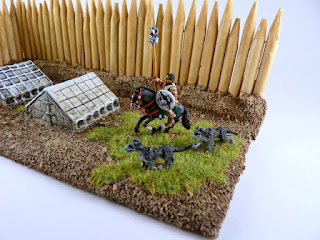Next, I needed to find some reference material for painting and playing gladiators. After asking around on TMP, I got a few recommendations and put in an order for 2 books. One of them is good enough to recommend! Gladiator - Rome's Bloody Spectacle by Konstantin Nossov can be had for a little as $10 for a hardbound book. I'm guessing that Osprey Publishing printed too many? Fast read and great pictures that I used whenever possible on this project.
Being a history lover, I thought I knew a fair amount about gladiators but this book exposed many gaps in my knowledge. Its full of fascinating tidbits and I'll share just a few: "Carthaginians are also known to have held gladiator games. At the very beginning of the Second Punic War, Hannibal attempted to boost the morale of his army by having captured mountain people fight each other using Gallic weapons. The prize-winner was to receive his freedom as well as armor and the horse. Every prisoner was eager to try his luck." (Nossov p. 13.)
Scipio got into the act in New Carthage, Spain: "The gladiators on this occasion were not drawn from the class from which the trainers usually take them-slaves and men who sell their blood-but were all volunteers and gave their services gratuitously. Some had been sent by their chiefs to give an exhibition of their instinctive courage of their race, others professed their willingness to fight out of compliment to their general, others again were drawn by a spirit of rivalry to challenge another to single combat. There were several who had outstanding quarrels with one another and agreed to seize this opportunity of deciding them by the sword on the agreed condition that the vanquished was to be at the disposal of the victor." (Nossov p. 14.)
During a slave revolt known as the Third Servile War, the leader of the revolt, former slave and gladiator Spartacus turned the table on the Romans when he provided a funeral in true Roman style-300 captured Roman legionaries fought each other as gladiators. (Nossov p. 16)
And like modern boxers, gladiators participated in a public event at the forum where any citizen could drop in and have a close look at the gladiators that were to fight in the arena the next day. (Nossov p. 135). Okay, enough yapping. Here's the first 4 figures I painted.
Referee Trainer: My first set of figures is not necessary for playing gladiator games. Instead, they'll be ornamentation during a game and as a side benefit, they were handy for getting my 28mm painting skills back up to snuff.
Hermes and Charon: According to one christian chronicler, once a gladiator match ended with the death of a gladiator, an odd ritual would take place. A person dressed as Hermes, the god of the dead, would enter the ring with a poker which he used to prod the corpse to confirm death. Another person, dressed as Charon, the ferryman of the dead, would enter the ring with a large mallet to smash the skull of any still living gladiator who'd been sentenced to death. Seems like a bit of overkill to me!
In the weeks ahead, I'll post pictures and the back story on all of the gladiator types I painted for this project. And for anyone who clicked in last night and couldn't find a Gladiator post, I apologize. I was working with tags and a post got published out of order. Even though I took it down, it was showing up in cross-linked blogs. :-(












